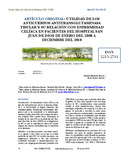UTILIDAD DE LOS ANTICUERPOS ANTITRANSGLUTAMINASA TISULAR Y SU RELACIÓN CON ENFERMEDAD CELÍACA EN PACIENTES DEL HOSPITAL SAN JUAN DE DIOS DE ENERO DEL 2008 A DICIEMBRE DEL 2010
UTILIDAD DE LOS ANTICUERPOS ANTITRANSGLUTAMINASA TISULAR Y SU RELACIÓN CON ENFERMEDAD CELÍACA EN PACIENTES DEL HOSPITAL SAN JUAN DE DIOS DE ENERO DEL 2008 A DICIEMBRE DEL 2010
| dc.creator | Barahona Brenes, Rándall | |
| dc.creator | Duarte Sancho, Paolo C. | |
| dc.date.accessioned | 2015-06-22T17:44:55Z | |
| dc.date.available | 2015-06-22T17:44:55Z | |
| dc.date.issued | 2011-05-01 00:00:00 | |
| dc.identifier.citation | http://revistas.ucr.ac.cr/index.php/clinica/article/view/6530 | |
| dc.identifier.issn | ||
| dc.identifier.uri | https://hdl.handle.net/10669/14704 | |
| dc.description.abstract | Background: Celiac disease (CD) is a smallintestine enteropathy that is caused by the ingestion of gluten protein in food. The main determinant found is the enzyme tissue transglutaminase, an enzyme of the small intestine. Thisstudy pretends to assess the validity of anti-tTGin patients admitted to HSJD with the diagnosisof CD, because the clinic experience suggests afewer sensitivity as the report in literature. Methods: The population studied was patientstwelve years or older with positive serology foranti-tTG and excluded patients receiving steroidsor immunosuppressive therapy, patients with gastrointestinal surgery, HIV/AIDS or being on aglutenfree diet. We consider patients as havingCD those with symptoms, classic pathological changes and/or a response to freegluten diet. Age, ethnicity, gender and frequency of chronic diseases were documented; and also sensitivity,specificity, PPV and NPV for anti-tTG was measured. A distribution according Marsh histological classification was made. The presence ofIgA deficiency was evaluated. Findings: We found CD was more frequent inwomen and older patients. The sensitivity andspecificity found for anti-tTG IgA was 17% and96%, whereas anti-tTG IgG was 14.2% and100% respectively. The PPV and NPV were 75%and 100% in the case of IgA and 65% and 62.5%for IgG. Most of the histologic specimens wereMarsh 3 or superior. IgA deficiency was notfound. Interpretation: The epidemiologic features in CD were similar to those describe in literature. It was not found classic associated disorders to CD. The validity of anti-tTG for diagnosis of CD waslower as described. | |
| dc.description.abstract | Introducción: la enfermedad celíaca (EC) es untipo de enteropatía que afecta el intestino delgado y se desencadena al ingerir alimentos quecontienen gluten. El principal determinante antigénico que se ha encontrado es la antitransglutaminasa tisular (anti-tTG), una enzima del intestino delgado. Este estudio busca determinar lavalidez de los anti-tTG en la población del Hospital San Juan de Dios (HSJD) en el diagnósticode EC ya que la experiencia clínica del centrosugiere una menor sensibilidad que la reportadaen la literatura. Métodos: se incluyó pacientes con edades mayores o iguales a doce años en los que se realizómedición de anti-tTG. Se excluyó pacientes condiagnósticos diferentes a EC, que estuvieranrecibiendo esteroides o inmunosupresores, pacientes con cirugía gastrointestinal; portadores de VIH/SIDA y pacientes que recibieran dieta librede gluten. Se seleccionó aquellos casos con diagnóstico de EC, considerándose como portadorcuando se tenía manifestaciones clínicas máshistología compatible y/o respuesta a la dieta singluten. Se procedió a describir la edad, etnia,sexo, procedencia y enfermedades concomitantesasí como a calcular la sensibilidad, especificidad,valor predictivo positivo (VPP) y valor predictivo negativo (VPN) de los anti-tTG IgA o IgG. Sedescribió el grado de severidad de las biopsiassegún la clasificación de Marsh así como la pre-sencia de deficiencia de IgA. Hallazgos: predominaron los pacientes del sexofemenino así como los grupos superiores deedad. La sensibilidad y especificidad encontradaspara anti-tTG IgA fue del 17% y un 96% mientras que para la anti-tTG IgG se obtuvo 14.2% y100% respectivamente. Los VPP y VPN fueron 75% y 100% en el caso de IgA y 65% y 62.5%en mediciones IgG. Muchas de las muestras histológicas fueron Marsh 3 o superior y no se encontró casos de deficiencia IgA en los pacientes estudiados. Conclusiones: en cuanto a las variables epidemiológicas la EC se comporta de manera similara lo descrito. No se encontró asociación conpatologías clásicamente asociadas con la enfermedad. La validez de las pruebas anti-tTG en lapoblación estudiada es mucho menor a la encontrada en la literatura. | |
| dc.format.extent | - | |
| dc.relation.ispartof | Revista Clínica Escuela de Medicina UCR-HSJD Vol. 2 Núm. 3 2011 | |
| dc.subject | anticuerpos antitransglutaminasa tisular | |
| dc.subject | enfermedad celíaca | |
| dc.subject | clasificación de marsh | |
| dc.title | UTILIDAD DE LOS ANTICUERPOS ANTITRANSGLUTAMINASA TISULAR Y SU RELACIÓN CON ENFERMEDAD CELÍACA EN PACIENTES DEL HOSPITAL SAN JUAN DE DIOS DE ENERO DEL 2008 A DICIEMBRE DEL 2010 | |
| dc.title | UTILIDAD DE LOS ANTICUERPOS ANTITRANSGLUTAMINASA TISULAR Y SU RELACIÓN CON ENFERMEDAD CELÍACA EN PACIENTES DEL HOSPITAL SAN JUAN DE DIOS DE ENERO DEL 2008 A DICIEMBRE DEL 2010 | |
| dc.type | artículo original | |
| dc.date.updated | 2015-06-22T17:45:00Z | |
| dc.language.rfc3066 | es | |
| dc.identifier.doi | 10.15517/rc_ucr-hsjd.v2i3.6530 |


